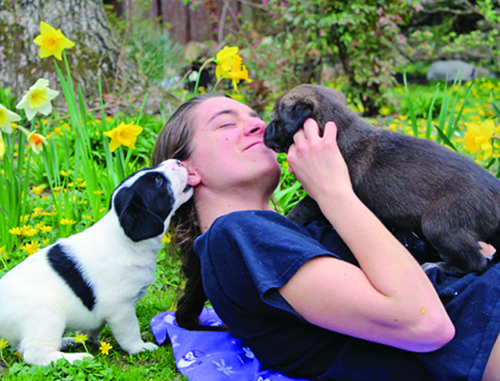
A pandemic has upended the globe, but here’s a little bright spot: puppy fostering is experiencing a golden era. Record numbers of people are offering to host a rescue pup, and they’re better positioned than ever to do a great job.
A shelter-like environment is always terribly risky for the youngest puppies. Enter the foster network, where volunteers provide in-home care for puppies who are not yet fully immunized. That can mean anything from enjoying one weekend with an 11-week-old pup to hosting a nursing mama and her litter for two months or more.
In normal times, many foster providers aren’t at home enough to promise any “extras” beyond keeping a pup safe and healthy. Thanks to COVID-19, though, many families are around 24/7, and in search of a fun, interesting, rewarding activity. Making the most of the almost magical canine “socialization window” can be just the ticket. Puppies who are not yet 4 months old are so impressionable that even a few days spent in an enriching environment can pay dividends forever. How about that for a worthwhile “stay at home” project?
BEHAVIORAL HEALTH GOALS
The best foster providers do far more than meet puppies’ physical needs; critically, foster families can also contribute to the puppies’ behavioral development. Puppies who have gained a wide variety of experiences in a safe, supportive environment will be far better prepared for the next phase of their lives – ideally, adoption into a forever family – than pups who saw the same four walls and busy kennel workers in a shelter environment.
There are four big life lessons I aim to teach my foster pups – to date, my family has hosted 175 – and each of those educational goals is easier because of this pandemic. In terms of getting puppies off to the right start, foster providers can knock it out of the park by leaning into this stay-at-home moment.
* LESSON #1: HUMANS ARE GOOD
A pup who is friendly and confident around people has a giant head start on a happy life. Frequent, relaxed interactions with different family members work beautifully to build the puppies’ strong positive association with humans.
Let’s say a family with three kids is fostering two skittish 9-week-old pups found under an abandoned porch. Normally, progress might be slow, with the family gone all day at work and school and engaged at night with sports and activities. But wait – now the parents are working from home, the kids are doing online school, and the activities are cancelled? That’s a bonanza for these puppies, whose days can now be packed with exposure. The pups can be set up in the middle of the action, perhaps in a pen in the kitchen. They can spend all day listening to five different human voices and getting used to how five different bodies move. The family can set a treat jar on the counter, so that each person can easily toss something yummy to the pups every single time they walk by.
Soon, instead of cowering in the back corner, those pups will be bounding over to interact. The transformation in behavior that could take weeks under normal circumstances might happen in two days.
Foster providers typically host nursing litters for a much longer time than the pair-of-pups scenario above. That offers even more chances to cement the “humans are good” lessons through the following actions:
• In the first weeks, foster providers can gently stroke the pups while they’re nursing, linking human touch with the happy feeling of nursing from mom (assuming mom is comfortable with this, too).
• Providers can progress to careful, strategic holding of each pup, gently touching toes and ears while pups are content and comfy near their mama.
• As pups begin to see and hear, the potential for interaction deepens. Five different family members, each hanging out in the puppy pen a few times a day, offers ideal exposure to various voices, bodies, and scents.
• As the pups grow, each person can feed them, introduce them to toys, cuddle them, and carry them on “field trips” to different areas of the house. The more household members are involved, the better.
By the time they are 8 weeks old and ready for adoption, these lucky pups will be gazing at any approaching human with calm, happy expectation.
Of course, a key part of getting pups accustomed to humans is introducing them to strangers, and that’s something that is challenging in this era of social distancing. Still, it can be done. Having dog-savvy friends drop by while you’re hanging out in the yard with pups is a good start.
* LESSON #2: NEW THINGS ARE FUN AND REWARDING
As pups approach 14 weeks old, biology tells them that anything they haven’t seen before just might be a threat. While that might help a pup survive in the wild, it is devastating to surprised owners when their previously bouncy, friendly pup becomes fearful.
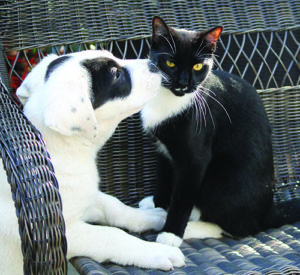
Foster providers can have a powerful impact on a puppy’s future by strongly counteracting biology’s lesson with this one: “New things are fun!” A big job for a puppy foster provider is to gently introduce as many novel sights and sounds as possible.
Pre-pandemic, asking volunteers to find the time for this seemed over the top. But now, with a little too many hours at home to fill, showing puppies something new sounds like a nice distraction. Here are some sample approaches, all of which should include reaction monitoring. Foster providers should pair the novel experiences with something positive: the presence of mom, littermates, or treats. Pup still worried? Back up and try again another day, because the whole point is for the pup to feel comfortable.
• Redesign the puppy area every few days by shifting the angle of the pen wall, moving the bed, using different bowls, and switching out items that hang in sight.
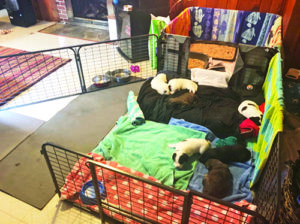
• Add different toys and bedding every day, and offer a new sort of flooring every few days, such as tile, newspapers, towels, carpet, and wood.
• Carefully use TV and radio, at a comfortable volume, to help puppies get used to all sorts of sounds: kids screeching, cars honking, etc.
• Take pups on field trips to different spots inside and outside the house, so they get accustomed to new places.
• Introduce puppies (when safe) to any other resident pets.
• Hang outside with the pups, so that they experience different kinds of weather, bird sounds, neighbor dogs barking, lawnmowers, etc.
• Have family members sometimes wear different hats, coats, boots, or backpacks as they interact with the pups.
• Give each pup short sessions of being separated from her littermates. Start with just a couple or three minutes and increase as their comfort level and confidence grows.
Foster providers can’t introduce puppies to every single thing they’ll ever encounter, of course, but the goal is to bring them around so many things that novelty actually becomes an expected part of life.
* LESSON #3: BEHAVIOR PAYS OFF
Pups want good things, namely food and fun. Unfortunately for them, they can’t hop in the car and drive to the pet store. Instead, they need to go through us. The kindest thing a foster can do is begin to give them keys to the kingdom, by teaching them that if they perform certain types of behavior around humans, it really pays off. Here’s how:
• When you approach a pen of puppies who are jumping and scrambling to get to you, wait just out of their reach. Somebody will get tired and sit down. The moment they do, pet or pick up only that one.
• Walk up to a lone pup with the food bowl. As he jumps to get it, hold the bowl over his head so he lands in a sit. The moment that he does, set the bowl down in front of him.
• You’re in the puppy pile and everybody is wrestling for your attention, but one pup sits and holds your gaze. Give that one a treat and a cuddle, while you ignore the rest.
After a week of consistent moments like this – made ever so much more possible when you’re home all day – you see puppies sitting in front of you whenever they’re hoping for something. The light has gone on! Instead of jumping for that treat in your hand, they have figured out how to get you to give it to them.
Looking to you for direction on how to get what they want is the cornerstone of beautiful canine-human communication and an absolute gift to give to a pup and her future adopter.
* LESSON #4: YOU GOT THIS!
In adult dogs, frustration and stress can lead to behavior problems, so it pays to help puppies learn to deal with those emotions. How? By giving them some practice. Fosters can have a powerful impact by allowing pups to experience small bits of stress that are quickly relieved every time:
• Deliberately let cabinet doors slam (gently at first!), pots clang, or a book drop now and then. The idea is not to startle and scare the puppies on purpose, but to gradually acclimate them to a normal, active household.Go ahead and vacuum, but at first, just for a few minutes at a time.
• As long as there are no health concerns, don’t intervene in the scramble for the best teat on mama. That competition can help a pup learn to persevere through the next frustration.
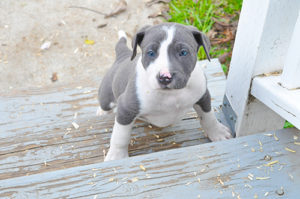
• Don’t rush to pick up the pup who has trouble climbing a step. Give encouragement instead. Once the pup gets over that step he’s much more likely to approach the next obstacle with calm confidence.
• Set up little blockages on the way to exciting things like food, people, or going outside. Some pups will quickly learn to find a way around that new pen or over that pile of towels, while others will sit and cry at the spot that used to be an opening. Offer support and company, but let the stymied pup solve the problem on her own.
It used to be hard for me to watch a pup feeling anxious or frustrated, so I’d jump in to fix everything. But now I sit back and think about how this tiny moment is helping to inoculate that pup against behavioral problems down the road, so I watch and smile.
GOOD FOR EVERY PUP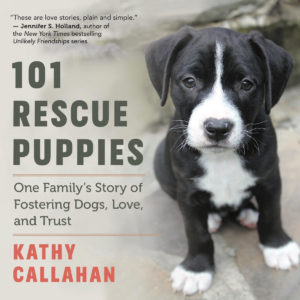
Of course, all puppies, not just foster puppies, will benefit from these four critical lessons. But there’s something special about teaching foster puppies. It’s a chance to do something good, for someone else. Sure, it’s “just” a puppy, but you’re helping set up a lifetime of happiness for that pup and a future owner. Right now, that feels particularly joyful.
Kathryn Callahan’s book, 101 Rescue Puppies: One Family’s Story of Fostering Dog, Love, and Trust, published by New World Library, is set to be released in September 2020. “This engaging, photo-filled book features the wonderful stories that emerge as these foster pups, typically from underfunded rural shelters, are suddenly surrounded by a nurturing family complete with generous-spirited adult dogs and curious cats. With a gift for capturing the moment in both words and images, Callahan brings readers inside the delightful, moving, and ultimately uplifting work of fostering.” The book is available now for preorder on Amazon.com.






This was a great article. Thank you for sharing!
Great article. Just finished one month with two Rottie pups 7-11 weeks. They were happy confident pups when adopted. The only thing you left out is the pain I felt when they left. It goes away eventually but it is real.
Thanks for sharing a great article! I really appreciate that!
Really liked that teaching a puppy perseverance & how to handle frustration early is necessary.
Wow love dogs
Beautiful dog. And look at the intelligence in those eyes. Wonderful writer. You are truly a healing spirit. Thank you.
This is really a great articles. Thank you for sharing this.I would definitely love to see some more blogs from you in the future. I have got some good accessories. I hope you will also love to see them. I am sharing the site link with you.